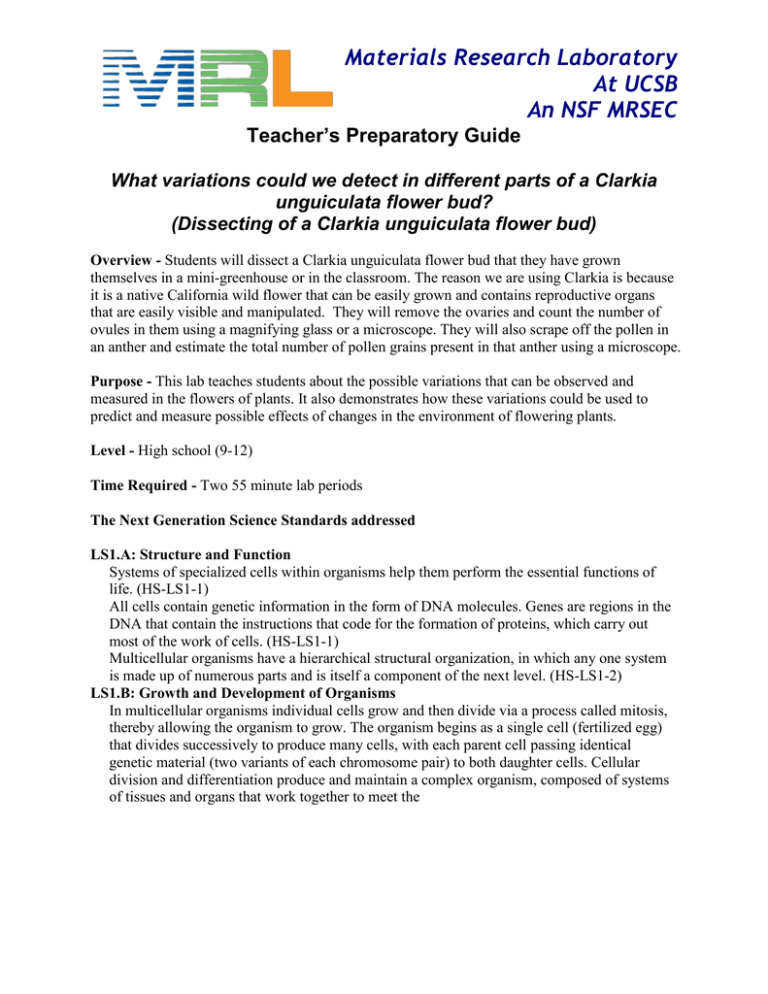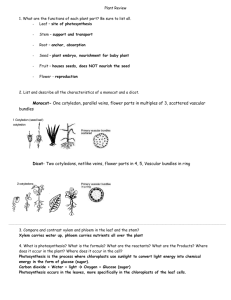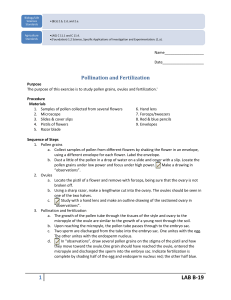TE-Dissecting Clarkia.doc
advertisement

Materials Research Laboratory At UCSB An NSF MRSEC Teacher’s Preparatory Guide What variations could we detect in different parts of a Clarkia unguiculata flower bud? (Dissecting of a Clarkia unguiculata flower bud) Overview - Students will dissect a Clarkia unguiculata flower bud that they have grown themselves in a mini-greenhouse or in the classroom. The reason we are using Clarkia is because it is a native California wild flower that can be easily grown and contains reproductive organs that are easily visible and manipulated. They will remove the ovaries and count the number of ovules in them using a magnifying glass or a microscope. They will also scrape off the pollen in an anther and estimate the total number of pollen grains present in that anther using a microscope. Purpose - This lab teaches students about the possible variations that can be observed and measured in the flowers of plants. It also demonstrates how these variations could be used to predict and measure possible effects of changes in the environment of flowering plants. Level - High school (9-12) Time Required - Two 55 minute lab periods The Next Generation Science Standards addressed LS1.A: Structure and Function Systems of specialized cells within organisms help them perform the essential functions of life. (HS-LS1-1) All cells contain genetic information in the form of DNA molecules. Genes are regions in the DNA that contain the instructions that code for the formation of proteins, which carry out most of the work of cells. (HS-LS1-1) Multicellular organisms have a hierarchical structural organization, in which any one system is made up of numerous parts and is itself a component of the next level. (HS-LS1-2) LS1.B: Growth and Development of Organisms In multicellular organisms individual cells grow and then divide via a process called mitosis, thereby allowing the organism to grow. The organism begins as a single cell (fertilized egg) that divides successively to produce many cells, with each parent cell passing identical genetic material (two variants of each chromosome pair) to both daughter cells. Cellular division and differentiation produce and maintain a complex organism, composed of systems of tissues and organs that work together to meet the Teacher Background Fig. 1 The basic parts of the flower are illustrated in this drawing. The stamen is the male part of the flower and it includes the anther where the pollen is produced and the filament which supports the anther. The female part of the flower is called the pistil and it includes the stigma which secrets a sticky substance to trap and guide the pollen to the ovary. It also includes he style which is the passage way to the ovary which contains the ovules that will develop into seeds once they are fertilized by the pollen. Mating systems in flowering plants can be divided into two basic types; cross-pollination and self- pollination. Cross–pollination can be defined as the type of mating system where the ovules of a flower receive pollen from a different flower of a different plant. Self-pollination can be defined as pollination in which the ovules of a flower receive pollen from an anther of the same plant and usually the same flower. Scientific evidence suggests that self-pollination or inbreeding generally tends to lead to plants that are less genetically fit, more homozygous, and thus more susceptible to changes in the environment. Scientists have been studying different species of Clarkia to document and determine the effect that climate change might have on the mating systems of different species of Clarkia and moreover on flowering plants in general. Their research has led to some startling discoveries. The research indicates that climate change has a great effect on the time that flowers bloom. This disruption could result in flowers missing the time when pollinators are present and thus the plant would have to rely more on self-pollination. Research with Clarkia has confirmed that in the absence of pollinators, plants will produce more flowers that can self- pollinate. In this lab, students will duplicate the techniques and methods used in the studies of Clarkia. They will examine a flower from a Clarkia plant that they have grown from a seed to count and compare the number of ovules it has with those of their classmates. And they will estimate and compare the total number of pollen grains that their flower contains. Sources 1. Dudley, L. S., A. A. Hove, and S. J. Mazer. 2012. The evolution of physiological rates in closely related Clarkia taxa: does selection explain phenotypic divergence between taxa? American Journal of Botany, 99: 488-507. 2. US. Dept. of Agriculture http://www.accessdata.fda.gov/scripts/cdrh/cfdocs/cftopic/pma/pma.cfm?num=p990026 3. ehow.com website http://www.ehow.com/how_7562804_identify-pollen-grains.html Materials per class (36 students) 18 Clarkia flowers 18 scalpels 18 Microscopes 18 Transparent grids 18 magnifying glasses(optional) 36 microscope slides masking tape pen/pencils Materials per student pair 1 Clarkia flower scalpel magnifying glass 2 microscope slides transparent grid microscope 2 microscope slides masking tape pencil/pen Advance Preparation – This lab is the second part that accompanies the growing of a Clarkia unguiculata seed. Prepare the transparent grids by making transparent copies of graph paper then cutting the transparencies into pieces slightly larger than microscope glass slide size. Safety Information - scalpels are sharp and can cut skin. When using microscopes, only low power to medium power is recommended when counting ovules and pollen as the slides can be rather thick and breakage of glass slides is a possibility if high power is used. Instructional Procedure Time Activity Goal Day 1 15 min Introduce students to flowers and why they are an important part of the plant. Show students YouTube videos and/or the PowerPoint (see Resources section) on the types of work being done to study the effects of climate change. To prepare students to appreciate the methods that they will use to perform this lab. 10 min Students define terms (in the Guided Dialog section). Read the ehow literature on counting pollen grain at http://www.ehow.com/how_7562804_identifypollen-grains.html and have students answer the questions in the Guided Dialog section. To ensure the student understands the parts of the flower and how flowering plants reproduce and some methods used in the study of the effects of climate change. 20 min Distribute Student Worksheets to students. Students follow procedures 1–3. Counting pollen grains. If students do not finish counting pollen the prepared slides could be saved in a refrigerator until the next day. Otherwise new slides can be prepared. To allow students to start the lab and try to could the pollen grains on the first day. 5 min Clean up. To prepare workspace for next class. Day 2 50 min Students can continue counting pollen if they did not finish activity from day 1. Then move on to counting ovules activity. To count the number of ovules in their flower’s ovaries. 5 min Clean up To prepare workspace for next class. HW Answer conclusion questions. Students may finish them for homework. To wrap up the activity. Teaching Strategies - This lab is best done individually or in groups of two students. Two 55minute periods are recommended. Guided Dialog Before beginning the lab, review the meaning of these terms: stamen the male part to the flower. pistil the female part of the flower. anther The of the flower that contains the pollen. pollen The male reproductive cell in flowering plants. filament The part of the flower that sustains the anther. stigma The part of the flower that receives the pollen. style A small tubular opening to the ovary. ovaries The part of the flower that contains the ovules. ovules The female reproductive cells. Cross-pollination Pollination that involves interchange of pollen among plants. Self-pollination Pollination that occurs within the same plant. Have students answer these questions: 1. What possible variations do you think you could detect in two flowers of the same plant? Flowers could differ in the number of ovules and pollen that each contains. 2. What effect could this have on the flowers? Flowers that contain less of either may be less likely to produce viable seeds and the opposite would be true of flowers that contain more pollen or ovules. 3. What effect could this have on the entire plant? Plants that produce less viable seeds would have a harder time surviving than those that produce stronger seeds. This could have a devastating effect on crops throughout the world. Procedure 1. Place an un-pollinated flower on dissecting pan or flat hard surface. Carefully remove or cut out all the petals and sepals in your flower bud revealing only the anthers and the ovary. 2. Scrap the pollen of one anther onto a glass slide. Choose any one of the large anthers you wish to count. And using your scalpel scrape all the pollen on the large anther onto your glass slide. After you have scraped all of the pollen add a drop of stain and place a cover slip your sample. 3. Counting pollen grains. Place the transparent grid on your microscope and place the slide on the grid. Carefully count the number of pollen grains present on one grid of your slide. Multiply this number by the number of grids that contain pollen to get an estimate of the number of pollen grains present in that anther. Multiply this number by 4 to estimate the number of pollen in the 4 large anthers. Scrape off the pollen grains of a small anther onto another microscope slide. Then count these pollen grains as you did with the large anther. Multiply this number by 4 and add this to the total from the large anthers. This is your estimate of the total number of pollen grains for your flower. 4. Revealing ovules Place the ovary of your flower on the dissecting pan or flat hard surface. Using your scalpel softly cut along the ridges of the ovary’s lengthwise. Make your cut from one end of the ovary to the other end. Then carefully open the ovary to reveal the ovules. 5. Counting the ovules Using the low power lens of your microscope or a magnifying glass and a probe, count the total number of ovules found in your flower’s ovary and record your results. Use probe to keep track of the ovules you have counted. Cleanup – Slides can be cleaned with warm water and all other flower materials can be thrown out. Going Further - Students who have a good grasp of the content of the lab can be further challenged with these questions: 1. What are some other ways that flowers could vary from each other? Another variation that plants could have is the distance between the anther and stigma and the size of the ovary and ovules. 2. How could these other ways be measure or detected? One could use varies means to measure distance and weigh differences in mass. 3. Design your own experiment to show how the data obtain from measuring these other variations could be used. Designs will vary. Assessment The student will be able to: a. Dissect a flower into its individual parts b. Estimate the number of pollen grains in a flower c. Determine the number of ovules in an ovary of a flower d. State the importance of studying and monitoring plants and animals in our environment. Resources 1. Dudley, L. S., A. A. Hove, and S. J. Mazer. 2012. The evolution of physiological rates in closely related Clarkia taxa: does selection explain phenotypic divergence between taxa? American Journal of Botany, 99: 488-507. 2. US. Dept. of Agriculture http://www.accessdata.fda.gov/scripts/cdrh/cfdocs/cftopic/pma/pma.cfm?num=p990026 3. ehow.com website http://www.ehow.com/how_7562804_identify-pollen-grains.html





